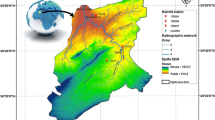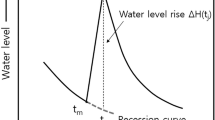Abstract
In this paper we developed a simple multiple linear regression (MLR) recharge model that relates the recharge estimates obtained from rainfall to the geophysical parameters obtained from the interpretation of two-dimensional (2D) resistivity imaging data for the purpose of efficient groundwater resources management in the southern part of Perak, Malaysia through recharge rate estimation and prediction. Through application of linear regression model, the estimated recharge from rainfall and the corresponding estimated unsaturated layer resistivity and its thickness (Depth to aquifer top) parameters obtained from geophysical measurements were regressed in R software written code environment for generating a MLR recharge model. The sensitivity of analyzed results of the MLR recharge model based on the parameter estimation of the model predictors (resistivity and depth) evaluated at Pr ≤ 0.05 is 5.39 × 10−06 and 8.39 × 10−04, respectively. The accuracy and predictive power test conducted on the developed model using both t test and \( \chi^{2} \) distribution at α = 5 % significance level established the model estimation and prediction capability. The obtained results of \( \chi^{2} \) distribution test and parameters estimation test confirmed the reliability and accuracy of the proposed model in recharge rate estimation and prediction in the area. The application of the MLR recharge model gives estimate of 242.30 mm/year for regional groundwater recharge rate in the area. Through GIS tool, the MLR recharge model was used to produce groundwater recharge rate prediction map. A quick and independent estimate of recharge by simple geophysical measurement has been established based on these results. The information on the prediction map could serve as a scientific basis for groundwater resources management and exploration in the area. The approach suggests a new application of geoelectric parameters in determining recharge rate due to infiltration. The technique provides a good alternative to other methods used for this purpose.







Similar content being viewed by others
Explore related subjects
Discover the latest articles and news from researchers in related subjects, suggested using machine learning.References
Aizebeokhai AP, Olayinka AI, Singh VS (2010) Application of 2D and 3D geoelectrical resistivity imaging for engineering site investigation in a crystalline basement terrain, Southwestern Nigeria. Environ Earth Sci 61:1481–1492. doi:10.1007/s12665-010-0464
Akpan AE, Ugbaja AN, George NJ (2013) Integrated geophysical, geochemical and hydrogeological investigation of shallow groundwater resources in parts of the Ikom-Mamfe Embayment and the adjoining areas in Cross River State, Nigeria. Environ Earth Sci 70:1435–1456. doi:10.1007/s12665-013-2232-3
Asry Z, Samsudin AR, Yaacom WZ, Yaakub J (2012) Groundwater investigation using electrical resistivity imaging technique at Sg. Udang, Malaka, Malaysia. Bull Geol Survey Malays 58:55–58
Bahaa-eldin EAR, Yusoff I, Abdul Rahim SWY, Wan Zuhairi MR, Ghani A (2011) Tracing subsurface migration of contaminants from an abandoned municipal landfill. Environ Earth Sci 63:1043–1055. doi:10.1007/s12665-010-0780-3
Barker R (1990) Investigation of groundwater salinity by geophysical methods. Geotech Environ Geophys 201–212. SBN:978-1-56080-278-5 print ISBN: 978-0-931830-99-0
Chandra S, Chand R, Rao VA, Singh VS, Jain SC (2004) Estimation of natural recharge and its dependency on sub-surface geoelectric parameters. J Hydrol 299(1):67–83. doi:10.1016/j.jhydrol.2004.04.001
Chandra S, Kumar D, Ahmed S, Perrin J, Dewandel B (2008) Contribution of geophysical methods in exploration and assessment of groundwater in hard rock aquifers. The 3rd International Conference on Water Resources and Arid Environments (2008) and the 1st Arab Water Forum 299 (2004), pp 67–83
Chaturvedi RS (1973) A note on the investigation of ground water resources in Western Districts of Uttar Pradesh. Annual Report, UP Irrigation Research Institute, pp 86–122
Cook PG, Walker GR, Buselli G, Potts IAR (1992) The application of electromagnetic techniques to groundwater recharges investigations. J Hydrol 130(1–4):201–229
De Vries JJ, Simmer I (2002) Groundwater recharge: an overview of processes and challenge. Hydrogeol J 10:5–17. doi:10.1007/s10040-001-0171-7
Doumouya I, Dibi B, Kouame KI, Saley B, Jourda JP, Savane I, Biemi J (2012) Modeling of favourable zones for the establishment of water points by geographical information systems (GIS) and multi-criterial analysis (MCA) in the Aboisso area (South-east of Cote d’Ivoire). Environ Earth Sci 67(6):1763–1780. doi:10.1007/s12665-012-1622-2
Ewusi A, Kuma JS, Voigt HJ (2009) Utility of the 2-D multi-electrode resistivity imaging technique in groundwater exploration in the Voltaian sedimentary basin, Northern Ghana. Nat Resour Res 18(4):267–275
Gontia NK, Patil PY (2012) Assessment of groundwater recharge through rainfall and water harvesting structures in Jamka micro watershed using remote sensing and GIS. J Indian Soc Remote Sens 40(4):639–648. doi:10.1007/s12524-011-0176
Islami N, Taib SH, Yusoff I, Ghani AA (2012) Integrated geoelectrical resistivity, hydrochemical and soil property analysis methods to study shallow groundwater in the agriculture area, Machang, Malaysia. Environ Earth Sci 65:699–712
Izuka SK (2006) Effects of irrigation, drought, and ground-water withdrawals on groundwater levels in the southern Lihue Basin, Kauai, Hawaii. US Geological Survey Scientific Investigations Report 2006-5291, p 42
Izuka SK, Oki DS, Engott JA (2010) Simple method for estimating groundwater recharge on tropical islands. J Hydrol 387(2010):81–89. doi:10.1016/j.jhydrol.2010.03.034
Jupp DLB, Vozoff K (1975) Joint inversion of geophysical data. Geophys J Royal Astron Soc 42(977–991):195
Jyrkama MI, Sykes JF (2007) The impact of climate change on spatial varying groundwater recharge in the grand river watershed (Ontario). J Hydrol 338:237–250. doi:10.1016/j.jhydrol.2007.02.036
Kaliraj S, Chandrasekar N, Magesh NS (2014) Idnetification of potential groundwater recharge zones in Vaigai upper basin, Tamil Nadu, using GIS-based analytical hierarchical process (AHP) technique. Arab J Geosci 7:1385–1401. doi:10.1007/s12517-013-0849-x
Koefoed O (1979) Geosounding principles 1: resistivity sounding measurements. Elsevier Science Publishing Co, Amsterdam
Koutsoyiannis A (1977) Theory of econometrics, 2nd edn. Palgrave, New York
Kumar CP (1977) Estimation of natural ground water recharge. ISH J Hydraulic Eng 3(1):61–74
Kumar CP (2000) Groundwater assessment methodology. National Institute of Hydrology, Roorkee, p 21
Kumar CP, Ish M (2012) Estimation of ground water recharge due to rainfall by modeling of soil moisture movement. The Indian Society for hydraulics. J Hydraulic Eng. doi:10.1080/09715010.1998.10514633. http://www.tandfonline.com/loi/tish20
Kumar CP, Seethapathi PV (2002) Assessment of natural ground water recharge in upper Ganga Canal command area. J Appl Hydrol 15(4):13–20. http://www.angelfire.com/nh//publication/ugcm.pdf
Leipnik RB, Loáiciga HA (2006) Radially convergent groundwater flow in sloping terrain. Hydrol Sci J (des Sciences Hydrologiques) 51(4):700–712. doi:10.1623/hysj.51.4.700
Loke MH (2004) Geoelectrical imaging 2-D & 3-D. Malaysia, Geotomo Software, p 133
Loke MH (2014) Inversion and interpretation of multi-dimensional resistivity surveys. Geotomo Software, Malaysia
Loke MH, Barker RD (1996) Rapid least-squares inversion of apparent resistivity pseudosections by a Quasi-Newton method. Geophys Prospect 44:131–152
Louis I, Karantonis G, Voulgaris N, Louis F (2004) Geophysical methods in the determination of aquifer parameters: the case of Mornos river delta, Greece. Res J Chem Environ 18(4):41–49
Mazac O, Kelly WE, Landa I (1985) A hydrogeophysical model for relation between electrical and hydrualic properties of aquifers. J Hydrol 79:1–9
Misstear BDR, Brown L, Daly D (2009) A methodology for making initial estimates of groundwater recharge from groundwater vulnerability mapping. Hydrogeol J 17(2):275–285
Mogaji KA, Omosuyi GO, Olayanju GM (2011) Groundwater system evaluation and protective capacity of overburden material at Ile-olujI, Southwestern Nigeria. J Geol Min Res 3(11):294–304
Mohamed SEJ, Shaharin I, Wan NAS, Puziah AL (2012) Groundwater resources assessment using integrated geophysical techniques in the southwestern region of Peninsular Malaysia. Arab J Geosci 6(11):4129–4144. doi:10.1007/s12517-012-0700-9
Mufid Al-Hadithi DCS, Israil M, Kumar B (2006) Groundwater-recharge estimation using a surface electrical resistivity method in the Himalayan foothill region, India. Hydrogeol J 14:44–50. doi:10.1007/s10040-004-0391-8
Neil HT (1990) Multivariate analysis with application in education and psychology, 2nd edn. Wiley, New York
Neil HT (2003) Multivariate analysis with application in Education and Psychology, Revised edition. Wadsworth publishing Company Inc, Belmont
Nimmo JR, Healy RW, Stonestrom DA (2005) Aquifer recharge. In: Anderson MG, Bear J (eds) Encyclopedia of hydrological science, vol 4. Universiti Sains Malaysia, Wiley, UK, pp 2229–2246
Niwas S, Tezkan B, Israil M (2011) Aquifer hydraulic conductivity estimation from surface geoelectrical measurements for Krauthausen test site, Germany. Hydrogeol J19(2):307–315. doi:10.1007/s10040-010-0689-7
Nolan BT, Healy RW, Taber PE, Perkins K, Hitt KJ, Wolock DM (2007) Factors influencing ground-water recharge in the eastern United States. J Hydrol 332(1–2):1–187. http://dx.doi.org/10.1016/j.jhydrol.2006.06.029
Oladapo MI, Adeoye-Oladapo OO, Mogaji KA (2009) Hydrogeophysical study of the groundwater potential of Ilara-Mokin Southwestern Nigeria. Glob J Pure Appl Sci 15(2):195–204
Omorinbola EO (2009) Empirical equations of groundwater patterns/equations. Hydrol Sci J 2–11. http://www.tandfonline.com/loi/thsj20
Pujari PR, Soni AK (2009) Sea water intrusion studies near Kovaya limestone mine, Saurashtra coast, India. Environ Monit Assess 154:93–109. doi:10.1007/s10661-008-0380-9
Rangarajan R, Athavale RN (2000) Annual replenishable groundwater potential of India-an estimate based on injection tritium studies. J Hydrol 234:38–53
Robins NS (ed) (1998) Ground-water pollution aquifer recharge and vulnerability. Geological Society, London, Special Publications 130, pp 107–115
Rubin Y, Hubbard S (2005) Hydrogeophysics. Springer, Dordrecht, p 523
Sasaki Y (1992) Resolution of resistivity tomography inferred from numerical simulation. Geophys Prospect 40:453–463
Sathish S, Elango L, Rajesh R, Sarma VS (2011) Assessment of seawater mixing in a coastal aquifer by high resolution electrical resistivity tomography. Int J Environ Sci Tech 8(3):483–492
Scanlon BR, Healy RW, Cook PG (2002) Choosing appropriate techniques for quantifying groundwater recharge. Hydrogeol J 10:18–39. doi:10.1007/s10040-001-0176-2
Shuy BE, Tan SBS, Chua CHL (2007) Regression method for estimating rainfall at unconfined sandy aquifers with an equatorial climate. Hydrol Process 21:3514–3526. doi:10.1002/HYP.6552
Simmers (1998) Groundwater recharge: an overview of estimation ‘problems’ and recent developments. Geological Society, London, Special Publications 1998, vol 130, pp 107–115. doi:10.1144/GSL.SP.1998.130.01.10
Wang I, Jin M, Nimmo JR, Yang l, Wang W (2008) Estimating groundwater recharge in Hebei Plain, China under varying land use practices using tritium and bromide tracers. J Hydrol 356(1–2):209–222
Xi C, Zhang Z, Zhang X, Chen Y, Qian M, Peng S (2008) Estimation of recharge from precipitation and evapotranspiration by Lysimeter measurement and soil moisture model. J Hydrol Eng 13(50):333–340
Yusoff I, Saghravani SR, Mustapha S, Saghravan SF (2013) Estimating groundwater recharge using empirical method: a case study in the Tropical Zone. Sains Malaysiana 42(5):553–560
Acknowledgments
This project was carried out using the financial support from RUI, Investigation Of The Impacts Of Summertime Monsoon Circulation To The Aerosols Transportation And Distribution In Southeast Asia Which Can Lead To Global Climate Change, 1001/PFIZIK/811228.
Author information
Authors and Affiliations
Corresponding author
Rights and permissions
About this article
Cite this article
Mogaji, K.A., Lim, H.S. & Abdullah, K. Modeling of groundwater recharge using a multiple linear regression (MLR) recharge model developed from geophysical parameters: a case of groundwater resources management. Environ Earth Sci 73, 1217–1230 (2015). https://doi.org/10.1007/s12665-014-3476-2
Received:
Accepted:
Published:
Issue Date:
DOI: https://doi.org/10.1007/s12665-014-3476-2




